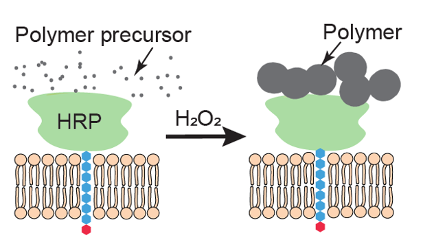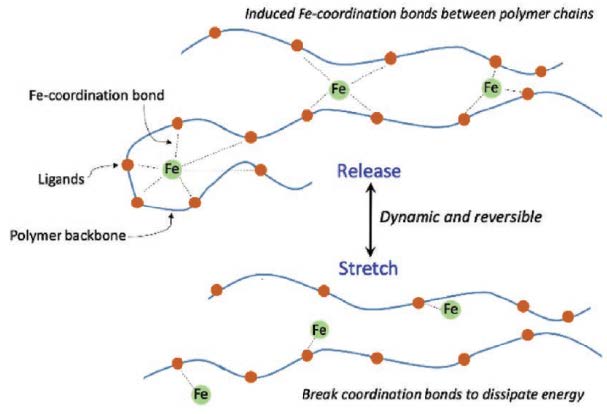-
A key to assembling materials on the surface of live neurons

Summary Anqi Zhang, a postdoctoral scholar at Stanford, transitioned from building brain implants to mastering genetic engineering. In collaboration with Professors Zhenan Bao and Karl Deisseroth, Zhang developed a protein complex that helps neurons assemble conductive materials, potentially changing their sensitivity and creating new electrical connections. By using cellular machinery, Zhang overcame challenges in enzyme […]
-
Improving performance of polymer semiconductors with metal-ligand based mechanophores

Summary With the rise of wearable electronics, developing materials that withstand mechanical strain without losing electrical performance is crucial. Polymer-based field-effect transistors (FETs) are key components but often brittle due to rigid molecular structures needed for charge transport. A team led by Professor Zhenan Bao and Dr. Hung-Chin Wu at Stanford University addressed this by […]
-
Strain-insensitive stretchable electronics for wearables

Summary Researchers led by Professor Zhenan Bao at Stanford University have developed intrinsically stretchable transistor arrays for wearable electronics, with high device density and strain insensitivity. The material maintains less than 5% performance variation under 100% strain, making it ideal for capturing physiological signals despite strain changes. The team introduced “elastiff” layers, using rigid and […]
-
Stretchable Battery Underpinned by Supramolecular Chemistry

Summary Wearable electronics require flexible, safe, and high-performance energy storage. Traditional Li-ion batteries, which are rigid and contain flammable liquid electrolytes, are not ideal for such applications. A research team led by Professors Zhenan Bao and Yi Cui developed a new type of solid-state polymer electrolyte, incorporating a supramolecular network with dynamic hydrogen bonding to […]
-
Monitoring of Intra-Tumoral Drug Pharmacokinetics In Vivo With Implantable Sensors

Summary Drug discovery is costly, with only about 10% of drugs in Phase 1 trials gaining FDA approval, largely due to poor understanding of pharmacokinetics (PK). Standard blood-based PK measurements don’t accurately reflect drug levels in tumor tissues, which have complex microenvironments. A team led by Professor Hyongsok Tom Soh developed an implantable electrochemical aptamer-based […]
-
Nanostructured Electrodes Improve Sensor Sensitivity with Faster Electron Transfer

Summary Electrochemical sensors convert chemical signals from target analytes into electrical signals for detection, making them valuable for biomedical applications. Sensitivity is crucial as clinical biomarkers are often present at very low levels, and electrochemical sensors help monitor drug concentrations like doxorubicin in biofluids. A team led by Professor Hyongsok Tom Soh at Stanford developed […]
-
Implantable device for wirelessly controlled drug delivery

Summary Researchers from Stanford University have developed an implantable, ultrasound-powered drug delivery device that integrates nanoparticles and electronics for targeted, on-demand drug release. The device uses a potentiostat to control drug release by measuring the current between electrodes, and it operates wirelessly through ultrasound, making it ideal for deep tissue implantation. The system allows precise […]
-
Stanford scientists uncover how brain regions keep each other on track

Summary Before smartphones, memorizing phone numbers was a common necessity, often accomplished by mentally repeating the number. The brain similarly solves short-term memory problems by maintaining patterns of neuronal activity. Researchers, led by Professors Shaul Druckmann and Nuo Li, studied how this occurs in mice by engaging their short-term memory. They discovered that two brain […]
-
A Window into Maternal Health Through Hair Cortisol

Summary Hair cortisol concentration (HCC) offers a promising non-invasive method to track stress hormone levels over time, particularly during pregnancy. Cortisol, crucial in the body’s stress response, is deposited into hair, reflecting past hormone levels. A study led by Dr. Lucy King at Stanford University examined HCC dynamics in pregnant women and postpartum, finding significant […]
-
Finding brain patterns underlying depression: linking functional neuroimaging tosymptom subtypes

Summary Researchers at Stanford University, led by Dr. Leanne Williams, are developing a framework that links brain circuit activity, observed via fMRI scans, to specific depression and anxiety symptoms. Traditional psychiatric labels fail to reflect the biological underpinnings of mental health conditions, but the study focuses on neural circuit dysfunctions, such as the default mode […]